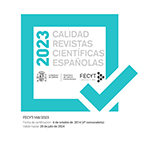Concilia o revienta: determinantes socioeconómicos y demográficos del uso de técnicas de reproducción humana asistida en perspectiva territorial
Resumen
Durante las últimas dos décadas ha crecido notablemente el número de mujeres que recurren a tratamientos de fertilidad y técnicas de reproducción humana asistida (en adelante TRHA). El aumento en la recurrencia a estas técnicas ha tratado de ser explicado en el ámbito de las ciencias de la salud a través de variables biológicas, genéticas y fenotípicas, pero apenas existen estudios que pongan de relevancia la influencia de factores socioeconómicos y demográficos para explicar el creciente uso de las TRHA. El presente artículo tiene por objeto indagar en el peso de distintas variables de carácter sociodemográfico y económico en la prevalencia del uso de las TRHA en las comunidades autónomas españolas. Para ello, a través de los datos de la Sociedad Española de Fertilidad, se ha analizado la influencia de factores como la tasa de actividad femenina, la edad media al primer matrimonio, la edad media al primer hijo, la tasa de fecundidad, el número medio de hijos por mujer, el nivel de estudios de las mujeres, o la tasa de empleo femenina en el número de ciclos de fecundación in vitro por cada mil mujeres en cada una de las comunidades autónomas. Los resultados muestran una relación directa y positiva de factores como la tasa de actividad femenina, la tasa de empleo femenino y el nivel de estudios de la población femenina. Asimismo, existe una relación de factores sociodemográficos como la edad media al matrimonio, la edad media al nacimiento del primer hijo, la tasa de fecundidad, o el número medio de hijos por mujer. Los resultados ponen de manifiesto una importancia crucial de los factores sociodemográficos y económicos en la recurrencia al uso de técnicas de reproducción humana asistida así como la necesidad de políticas de conciliación que permitan un adelanto en la edad de nacimiento del primer hijo.
Descargas
Descarga artículo
Licencia
La revista Política y Sociedad, para fomentar el intercambio global del conocimiento, facilita el acceso sin restricciones a sus contenidos desde el momento de su publicación en la presente edición electrónica, y por eso es una revista de acceso abierto. Los originales publicados en esta revista son propiedad de la Universidad Complutense de Madrid y es obligatorio citar su procedencia en cualquier reproducción total o parcial. Todos los contenidos se distribuyen bajo una licencia de uso y distribución Creative Commons Reconocimiento 4.0 (CC BY 4.0). Esta circunstancia ha de hacerse constar expresamente de esta forma cuando sea necesario. Puede consultar la versión informativa y el texto legal de la licencia.











